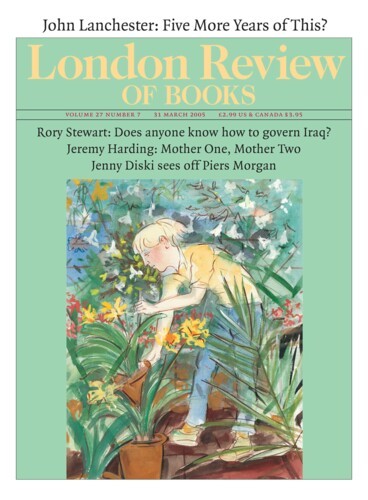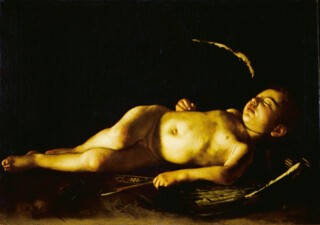The total area of sky in Caravaggio’s paintings covers, by my count, no more than a few square inches tucked away in the corners of two quite early pictures. Otherwise his subjects are set up on crowded, enclosed stages. As time goes by general illumination is replaced by angled shafts of light. If the action takes place outdoors it is at night by lantern light. The even light of the early pictures – the Gypsy fortune-teller, the card sharps, the boys with lutes and grapes – gives way to scenes in which strong illumination from an implied door or window strikes faces and bodies selectively. His most powerful and coherent compositions – the Calling of St Matthew in the Contarelli Chapel in S. Luigi dei Francesi in Rome, for example – use light to dramatise essentials. In that picture it streams past Christ to highlight the faces of the saint and his companions who are gathered round a table.
Bodies overlap. The shadow cast by one figure obscures the face of its neighbour. Other faces are in the dark because they are turned away from the single light source. There is hardly any architecture, only plain walls and undifferentiated gloom. When a column is needed for Christ to be tied to, it is without fluting. A rusticated arch in the late Beheading of St John and the manger in a Nativity are unclear. Clouds supporting angels and broad swathes of drapery may make strong patterns against these backgrounds, but even the angels seem to be contained in the same shallow space as the other figures.
Photographers and cinematographers were the last Caravaggisti; it is Caravaggio light that first picks out Harry Lime’s face in The Third Man, and it was that combination of highlight and shadow which photographers discovered when they began to take pictures using available light in dim places: Brassaï, for instance, let shadows edit his images of Paris at night.
To look at late Caravaggio (Caravaggio: The Final Years is at the National Gallery until 22 May) without earlier Caravaggios in mind is like taking your seat for a Jacobean tragedy only as the curtain rises on the last act. But it is a last act worth seeing – in particular because these pictures are harder than most to get to see. The paintings Caravaggio made between 1606, when he killed a man in a duel in Rome, and his death in 1610 are still, on the whole, to be found where he painted them – in the places he stopped on a restless, fugitive’s itinerary which took him backwards and forwards between Naples, Malta and Sicily. It is also a last act which changes one’s sense of what went before; in his last years Caravaggio became more of a religious painter, rather than merely a painter of religious subjects. Wonderful records of posed models are replaced by intense accounts of actors at work.
The curators of the exhibition make the connection between Roman Caravaggio and Southern Caravaggio nicely. The first picture you see in the exhibition is the National Gallery’s own Supper at Emmaus of 1601; next to it is another picture of the same subject which, although it was painted in Rome only five years later and is essentially the same composition, belongs in style and feeling with the work of his last years. The earlier version is striking in its lack of religious decorum. You attend to Caravaggio’s ability to create an illusion, not to the story of how Christ, after his death, appeared at Emmaus. The beardless, plump-cheeked Jesus is an example of how Caravaggio found unholy models for holy figures (he was regularly commissioned to paint altarpieces which were almost as regularly rejected, or at least criticised for their lack of propriety). Once you have responded to the way the foreshortened arms of Christ and the forward-leaning man with his back to you draw you into an imagined space, your eye turns to the white tablecloth which their gestures seem to measure and enclose. You now have a quite different picture to attend to – a still life of food. There is bread, a basket of fruit, a roast fowl, a glass of wine, a jug and a carafe. In the later painting, Christ is a bearded, more or less traditional figure; the feast is reduced to bread, a pottery jug and a few salad leaves. The still life in the first picture is an offering to the eye which looks back to what first made Caravaggio’s reputation: realistic renderings of fruit, musical instruments and – added one feels as another pretty thing – boys. In the second picture, which is much less glossily painted and, in a way, less technically assured, you attend to a drama, a moment of revelation.
Think of Caravaggio’s beginnings as a painter of still life and much falls into place, in particular the way his contemporaries judged him and his predilection for skyless interiors and the shallow stages which take the place of the still-life painter’s narrow shelf with wall behind. Bellori, whose biography was published in 1672, tells how Caravaggio went to Rome but could not afford models ‘without which he did not know how to paint’, and so he took up employment with Cavaliere d’Arpino as a painter of flowers and fruit. Later,
he began to paint according to his own inclinations; not only ignoring but even despising the superb statuary of antiquity and the famous paintings of Raphael, he considered nature to be the only subject fit for his brush. As a result, when he was shown the most famous statues of Phidias and Glykon in order that he might use them as models, his only answer was to point towards a crowd of people saying that nature had given him an abundance of masters.
His fame grew, particularly among young painters, but the complaint that he had somehow avoided higher tasks – invention and the creation of ideal beauty – was still voiced by his peers. To need models (not just for studies, but to paint your figure composition from) made the artist a mere copyist. What was confusing was that inventive magic, for all its virtues, could not match the power of the copyist’s images.
Caravaggio seems to have worked swiftly, delivering work on time in an age when many painters were notorious for missing deadlines, but, Bellori writes, his ‘preoccupation with painting did not calm his restless nature. After having painted for a few hours in the day he used to go out on the town with his sword at his side, like a professional swordsman, seeming to do anything but paint.’
With these comments in mind one can pursue the idea that Caravaggio’s great multifigure compositions were painted equivalents of Rejlander’s photograph The Two Ways of Life (1857) – a single scene stitched together from many negatives – and see why their power could seem a cheat to painters who pursued art more assiduously and nature less attentively.
To contrast the earlier inventions that take their strength from the direct transcription of poses with the later pictures in which the poses become less strikingly realistic and the expressions and gestures more eloquent, is to feel that his way of working had, to some degree at least, changed – and with it, or because of it, his way of thinking pictorially. Figures are still crowded together, but in frieze-like lines rather than complex knots. The space of the stage still seems narrow (the shepherds in the Messina Adoration of the Shepherds of 1609 are so close-packed they look like cut-out figures that have been pasted over one another) but the action is more emotionally coherent.
Caravaggio’s painting, stroke by stroke, is not lovely. In the late pictures (many of which are in poor condition) some of what seems crude may be restoration, but all his work looks best when you stand away from it. His take on the nature of the human animal and its predicament (perhaps his own predicament, but while the drama of his life can be illustrated from the paintings, the paintings are better left to speak for themselves) is harsh.
One of the strangest pictures in the exhibition is a sleeping Cupid. This baby with wings suggests the weakness of the newborn, not the muscularity of those chubby putti who are not quite baby and not quite child. Light comes from low down on the left, so that the underside of the chin, nose, cheeks and eye sockets are lit; this is the deeply unflattering light you get when a child puts a torch under its chin to spook you; it is lighting which, in Caravaggio, speaks of death: it is how Mary in the Death of the Virgin (painted during his last year in Rome) is lit, Lucy in the Burial of Saint Lucy and Lazarus in the Raising of Lazarus. Caravaggio’s regular side lighting strikes them this way because the dead are lying down – but it has the effect of making one wonder if Cupid, too, is dead. Perhaps it is because he didn’t study ancient sculpture that none of his bodies has the perfectly articulated musculature which in real life is found less often than softer and smoother or stringier flesh. Saint Andrew in the Crucifixion of St Andrew of 1607 has the meagre body of a marathon runner; Christ in the Flagellation of the same year twists and looks down as though working out a complicated dance step: his body has the weight of a rugby forward. In these late figures, in which the reality of the body and the pathos of the subject are truly integrated, early Caravaggio’s ability to suggest perverse charm, as in the cheeky, frontal nudity of Amor Vincit Omnia (1601-02), has finally filled an emotional spectrum wider than that of most great painters.
Send Letters To:
The Editor
London Review of Books,
28 Little Russell Street
London, WC1A 2HN
letters@lrb.co.uk
Please include name, address, and a telephone number.


